Table of contents
- Guide to downtime and petrol What should you watch out for with fuel??
- Which octane number is the right one for my motorcycle?
- What do I have to consider in the case of long downtimes??
- Is the consumption higher with E10?
- Which petrol do I fill up with if I park for a long time??
- Is old gasoline in the tank harmful??
- What happens when oxygen comes into contact with fuel?
- Additives in gasoline help?
- That’s what the gasoline specialist says
- This is what the additive professional advises
- Conclusion
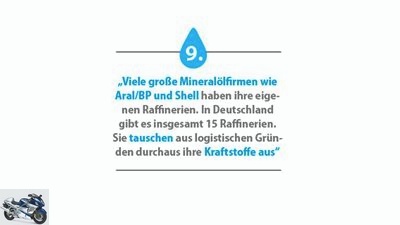
Mona Pekarek
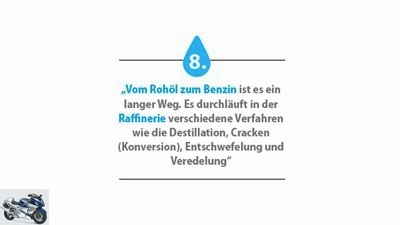



10 pictures
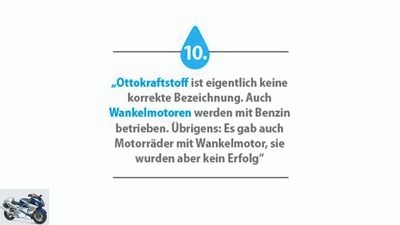
1/10

2/10

3/10

4/10

5/10

6/10

7/10

8/10

9/10

10/10
counselor
workshop
Guide to downtime and petrol
Guide to downtime and petrol
What should you watch out for with fuel??
When and how does gasoline age? Do additives help? And what does vitamin E have to do with it? We provide answers.
Mona Pekarek
06/09/2021
In this article:
- Which octane number is the right one for my motorcycle?
- What should I watch out for in the event of long downtimes??
- Is the consumption higher with E10?
- Which petrol do I fill up with if I park for a long time??
- Is old gasoline in the tank harmful??
- What happens when oxygen comes into contact with fuel?
- Additives in gasoline help?
- That’s what the gasoline specialist says
- This is what the additive professional advises
- Conclusion
Whether four or two-stroke, carburetor or injection system, single or six-cylinder, V4 or boxer – they all have at least one thing in common: nothing works without fuel. In combustion engines, fuel and air are compressed by the piston, then ignited – and whoosh, the chemical energy stored in the gasoline is released. If an engine is running regularly, this complex and at the same time simple system runs relatively smoothly in the literal sense of the word: gasoline comes in, constantly flushes lines, nozzles and fuel system through, with only small deposits arising as a waste product of combustion.
Which octane number is the right one for my motorcycle?
Of course, not every engine concept and every motorcycle can be lumped together, especially since a modern super sports car has completely different requirements than an old two-stroke enduro. For example, the latter does not really care about the octane number and would even run on petrol below the European standard of at least 95 octane.
However, the octane number prescribed by the manufacturer must not be undercut, especially in the case of high-performance engines. Practical gasoline customer: A KTM RC8 had a hole in the piston in the MOTORRAD test after only three kilometers full throttle with 95-octane fuel instead of Super Plus 98; a major engine failure. A higher octane number means more knock resistance, i.e. a more controlled and precise ignition of the mixture. In the case of the RC8, there were spontaneous, unwanted flame fronts in the engine, which collided with the regular one, which led to enormous pressure peaks.
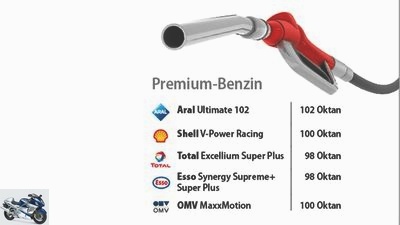
Fotolia
Premium gasoline: A higher octane number means more knock resistance, i.e. a more controlled and precise ignition of the mixture.
Petrol not only has to ignite at the right time, but more importantly, ignite at all. Its various hydrocarbons evaporate or boil in a range between 30 and 200 degrees Celsius, thus enabling the gasoline-air mixture to ignite over a wide temperature and operating range. In the case of a cold start, the volatile constituents of gasoline are particularly important – more in winter than in summer. Volatile means: over a longer period of time, gaseous molecules gradually escape from the gasoline, diffuse out of plastic tanks and find their way through the ventilation system from metal fuel drums. If the vehicle is not used for a long time, this is a major aging factor, petrol becomes heavier (less light components), and ignitability is reduced.
What do I have to consider in the case of long downtimes??
Over the winter break, especially at low temperatures – and the experts still agree on this – this is the least of the problem. So what should you watch out for when mothballing, what happens to the gasoline in the tank, how and why should you take countermeasures? Basically, gasoline is a product with a limited shelf life. Aging begins as soon as it leaves the refinery and thus its place of origin. According to BP, operator of the largest German petrol station network Aral, their premium petrol Ultimate 102 can be safely stored for around a year if stored correctly – see the interview with petrol specialist Wenzel Strojek (see below).
The southern German motor oil, lubricant and additive manufacturer Liqui Moly estimates the durability of most fuels to be lower and warns of problematic signs of aging after only three months of storage. Above all there is the question of how exactly the gasoline is stored. How much light and air get into the fuel and what temperature fluctuations it is subject to play a role here. Therefore, oil companies cannot give an exact expiry date, after all they sell petrol unpackaged and not in sealed containers.
Is the consumption higher with E10?
Another important factor is which gasoline was used. At Aral, for example, the Super 95, Super Plus 98 and premium petrol such as Ultimate 102 differ in their octane number, but also – important for storage – between E5 and E10. These key figures indicate the proportion of so-called bio-ethanol, i.e. added alcohol from renewable raw materials.
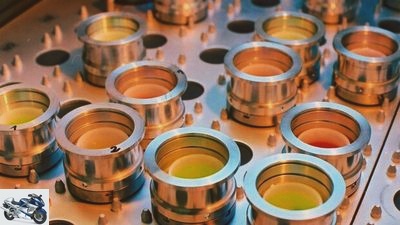
Aral / BP
The research department of BP / Aral regularly examines fuel samples in Bochum. Expensive, but definitely worth it.
In general, the cheaper and more environmentally friendly E10 fuel (less CO2!) Is said to have a higher consumption. A MOTORRAD test in 2011 on 30,000 kilometers confirmed this to a limited extent: the E10-fueled fleet consumed almost one percent more, about 0.06 liters per 100 kilometers. In this respect, the price advantage over E5 would still be positive.
The problem of ethanol in fuel lies elsewhere – and that brings us back to our topic, storage. As is well known, alcohol has a very long shelf life if you look at its vintages in the schnapps showcase. Nevertheless, it damages the fuel if it is not used for a long time: Ethanol is hygroscopic, so it attracts water from the ambient air.
Which petrol do I fill up with if I park for a long time??
Contrary to some statements that this is precisely what is good for wintering because it binds the water in the fuel, the experts at Liqui Moly and Aral agree: it is essential to fill up with ethanol-free fuel, but at least E5, not E10! The goal is not to bind as much water as possible in the gasoline, but rather not to get it into the tank in the first place. Aggressive water phases and rust form, especially with older metal tanks and longer storage; Corrosion attacks metal parts in the fuel system.
Mixtures of ethanol and water are very aggressive. They are specifically heavier than gasoline, sag and could be “Solvent” For example, rust can destroy the seams of metal tanks.
Is old gasoline in the tank harmful??
Premium fuels such as Aral Ultimate 102 or Shell V-Power Racing do not contain any ethanol, even if petrol stations have to show this because of possible small traces on the pump. So open your wallet for the expensive “Premium gasoline”? Well, know how. It is true that some air always gets into the gasoline through tank ventilation and the like. Nevertheless, refueling helps this “Tank breathing” to minimize. There is no cavity between the gasoline and the inner wall of the tank, less oxygen reaches the fuel, and less condensation can form. In the case of overwintering, this initially applies to all types of tanks.
If stored for a long time, the force threatens to diffuse through the plastic and loosen components from it – that is “Plastic tanks” it is better to empty and conserve completely in the case of longer periods of inactivity. Even if metal tanks are out of service for a long time, completely dry storage is worthwhile, but this also entails the preservation and greasing of all parts of the fuel system. However, if it is only a few cold months, as usual, you should definitely empty the carburetor (if available). It is particularly prone to corrosion and deposits. So either open the drain plug and carefully catch the gasoline flowing out or empty the float chambers with the gasoline valve closed and the engine running.
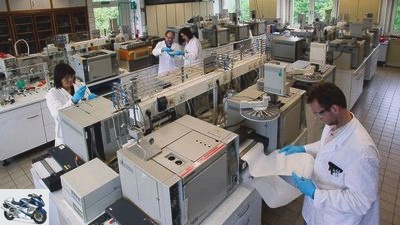
Liqui Moly
In the laboratory and in test vehicles: Liqui Moly tests additives such as the gasoline stabilizer extensively and explicitly before they are launched
Let’s be clear: When gasoline ages, the low-boiling substances that are important for a cold start evaporate first. The unavoidable supply of air in the fuel system also causes water to collect in the tank – the risk here is lowest with ethanol-free petrol. Water promotes corrosion and can damage the tank and pipes.
What happens when oxygen comes into contact with fuel?
The third undesirable process is oxidation. According to chemist and fuel researcher Wenzel Strojek from Aral, two types of compounds can be formed by oxygen that reaches the fuel: “Unsaturated compounds in fuel, called olefins, can react with oxygen in the air. On the one hand, small amounts of corrosive acids can develop, on the other hand, polymers, i.e. long-chain compounds that are no longer soluble in the fuel, are formed.” This resinous smear can clog lines, carburetor or injection nozzles. Restorers know this annoying phenomenon as gum build-up. The reaction of ethanol in fuel to acetic acid is also discussed.
Now there are probably two ways to counter these risks: wait, trust in the right preparation such as good storage conditions and accept the possible grumbling when you wake up in spring. Since no one can say exactly when exactly the fuel in the tank starts to oxidize, when and how much water exactly stimulates corrosion, this method can definitely work. Especially if you only park your motorcycle for a few weeks.
The second option is active prevention. For comparison: Even an unlubricated chain works, somehow, but certainly not forever. The old fuel may still work. The only question is how the condition of the bike and gasoline has changed over the years: With the simple Yamaha SR 500 (Top-Test MOTORRAD 10/2018), E5 gasoline no longer ignited after one and a half years of inactivity: the tank first had to be full be emptied.
Additives in gasoline help?
So wait or take precautions – beauty or basic? Our experts think: take precautions. And so they are more similar in their statement than expected. There are two types of special additives that are added to gasoline for storage and stabilization. Wenzel Strojek from Aral / BP speaks of a whole “Additive package”, that is added to your Ultimate 102 (here also with a different base fuel) by default. You fill it up right away. Such additives are the only big difference between common fuels from different gas station brands.
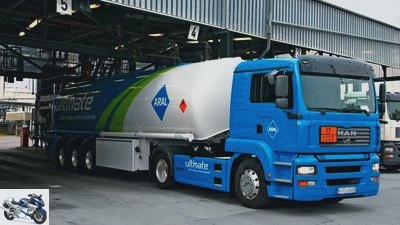
Aral / BP
The respective additive to the base fuel is only added to the base fuel at the “end point dosing” directly before the tanker is loaded.
David Kaiser, head of research and development at Liqui Moly, nevertheless recommends a separate additive, the gasoline stabilizer, for the storage of gasoline. Corrosion protection forms a thin molecular layer on the (metal) surfaces and protects them; Antioxidants, similar to vitamin E for humans, would slow down the aging of the gasoline. Are these perhaps the same agents that premium gasoline already contains? The chemist replies: “Corrosion protection is often already included, sometimes also antioxidants, as well as cleaning additives. The whole thing, however, usually in a lower concentration.”
Finally, Wenzel Strojek from Aral / BP describes very similar components in their additive package, plus cleaners and friction reducers. The advantage lies in the fact that these are already mixed into the fuel in a precisely adjusted dosage. If additives are then added to the tank at a later date, it cannot be ruled out that there will be negative interactions or even an overdose. This could lead to deposits in the fuel system.
What now? Legitimate question. It is clear that oil companies do not recommend any additional funds. Otherwise they would describe their own product as being in need of improvement. Ultimately, there is neither a standard for gasoline stabilizers nor an exact list of what they contain. “You can never be sure that these will not have a negative impact after all”, says Wenceslaus Strojek. “It opens the door to charlatans,” agrees with Kaiser von Liqui Moly and insures one “extensive testing” of their products. The European standard for fuels DIN EN 228 states: “The use of additives is permitted to improve quality.” However, there are no test methods that “Tendency to form deposits” determined.
In the manual for the current 790 Duke, KTM recommends: “Add fuel the last time the motorcycle is refueled before taking the motorcycle out of service.” Yamaha is the same as with the current MT-09: “Fill the fuel tank and add fuel stabilizer.” Although the respective cooperation brand is recommended, others are not excluded per se, but only pointed out to the high quality of the funds. It is therefore essential to read the motorcycle manual carefully before use in order not to risk losing the guarantee if these additives are prohibited!
That’s what the gasoline specialist says

Wenceslaus Strojek
Wenzel Strojek: The chemist has been employed in fuel research at Aral / BP in Bochum for over ten years. After working in fuel development and analysis, he is now mainly working on new fuels.
Which petrol do you recommend for storage?
We would definitely recommend Ultimate 102. We do not add any ethanol to this high-performance fuel. Fuel containing ethanol can draw water in storage for long periods of time. This can lead to the formation of a water phase, which can have negative consequences such as corrosion in the metal tank or in engine operation. Of course you want to avoid that. In addition, thanks to its special composition, Ultimate 102 facilitates cold starts even after long periods of storage. In Germany, this fuel is only produced in a refinery and is only available at Aral petrol stations.
But it says at the pump “up to five percent ethanol”?
We are obliged to note this, as the legislature has decided to display fuels with up to 5% ethanol and fuels without ethanol in the same way for the sake of simplicity. Ultimate 102 can only contain minimal traces of ethanol.
How long will Ultimate 102 last??
In a series of tests, we have found that the fuel can be used without any problems after one year if stored properly. Even after two years we found only small amounts of aging products. However, the specific storage conditions are always decisive for the shelf life of fuels. We recommend keeping the gas phase in the tank above the gasoline as small as possible. Therefore, the tank should always be topped up to the maximum permitted before the winter break; this prevents the entry of moisture and atmospheric oxygen.
How do you feel about additional, stabilizing additives??
All of our branded fuels contain additive packages that have been specially developed by us. We have extensively tested their effect. We therefore do not recommend any additional additives.
In fact, your additives and the external ones aren’t very similar?
In the case of an additive package, it depends on the one hand on the specific molecules used and on the other hand on the optimal combination of the various active ingredients. More additive does not mean more effect, but the right dose of the active ingredients is crucial.
So it already contains antioxidants and corrosion protection?
Of course, a corrosion inhibitor forms a protective layer on metal surfaces, so to speak. Antioxidants are also contained in gasoline, they make an additional contribution to delaying the aging phenomena.
This is what the additive professional advises

Liqui Moly
David Kaiser: As head of the research and development department at Liqui Moly, the chemist knows exactly how the gasoline stabilizer works.
How does the gasoline stabilizer work, what’s inside?
It is a carrier fluid that contains antioxidants, comparable to vitamin E for the body. Corrosion protection consists of molecules that are deposited on metal surfaces, where they form a very thin molecular layer that adheres very well. This prevents water from reaching these surfaces.
Premium petrol does not already contain additives so that yours is no longer needed?
The quality of fuel is defined in the European standard for petrol EN 228. As soon as the fuel leaves the refinery, however, aging begins and, like food, petrol has a limited shelf life. Regarding the additives: Often a corrosion protection is actually already included, antioxidants also sometimes as well as cleaning additives. Most of the time, however, in a lower concentration.
Your product makes sense all year round?
So, I don’t need preservation or stabilization all year round. It makes more sense to use our other additives.
There is no standard for fuel additives …
Right, there is no test standard. Of course, this also opens the door to charlatans. So we’ve already found everything – from harmful or ineffective to highly effective products.
Which products are harmful??
Since it doesn’t have to be written out, it’s hard to say. In Thailand, for example, we found glycerine-based products that then led to engine damage. We have also found pure ethanol. If you then pay 20 euros for a liter of alcohol, that is also excessive, and the effectiveness is not given.
Some manufacturers prohibit the use of additives per se …
That’s right, you write: no additives. If they would allow it, in case of doubt they would be liable if engine damage occurs due to these (non-standardized additives, ed.). On the other hand, the manufacturers also write that fuel in accordance with the EN 228 standard must be used. The standard says: The use of additives is expressly desired in order to improve the quality of the fuel if the additives do not have any negative effects. Our additives have been tested and have no negative effects on the quality of the gasoline; the fuel meets the standard even after our additives have been added. We therefore do not see our additives as an exclusion criterion for vehicles.
Conclusion
Not only the experts, the scene is also divided. Everyone smears, everyone cleans, but opinions differ when it comes to gasoline. Some swear by extra funds, others by premium fuel, and many are waving their hand. At least one thing is certain: be careful with lower-quality petrol from non- or Eastern European countries. It often does not contain any additives, neither for stabilization nor for cleaning. If you send your motorcycle off for a longer break, separate additives are definitely worthwhile. Premium fuel and the extra funds promise something similar. However, the stabilizing effect of both variants has not been proven. The worst case scenario is if you exclude backyard products: no effect at all. Including: a reassured conscience.
Related articles
-
Workshop guide: hoses and clamps
Schermer counselor workshop Workshop guide: hoses and clamps Workshop guide Hoses and clamps To ensure that air, fuel and coolant get exactly where they…
-
TuneUp 2.0 Tuning and Conversion Guide Honda Fireblade
Ines Mannl 17th pictures Ines Mannl 1/17 Don’t worry, it has to be that way! Even if this Honda is not ready to drive, it all serves a higher goal!…
-
Guide: Technology – engine lubrication
BILLION counselor workshop Guide: Technology – engine lubrication Guide: Technology – Motors and Drive Everything about engine lubrication To ensure…
-
Conversion and tuning guide optical tuning Suzuki GSX-S 1000 1-2
Ines Mannl 21 pictures triplespeed headquarters / Ines Mannl 1/21 How it all started: With a standard Suzuki GSX-S 1000. Technically first class, the…
-
Motorcycle transport solutions Caravans, mobile homes, trailers, transport systems Herder to travel Motorcycle transport guide Motorcycle transport guide…
-
Photos: Franz Josef Schermer counselor workshop Workshop guide Workshop guide – provisional Recognize botches on the motorcycle Recognize botches on the…
-
Guide to changing the brake pads on the motorcycle
Ralf Schneider counselor workshop Guide to changing the brake pads on the motorcycle Change the brake pads on the motorcycle Tips from professionals…
-
Gasoline: the pros and cons of E5 and E10
jkuenstle.de counselor workshop Gasoline: the pros and cons of E5 and E10 Report: All About Gasoline Part 3 Gasoline: the pros and cons of E5 and E10…
-
archive counselor workshop Driving guide in autumn Advice: Driving in the fall Final preparation for autumn drivers For some, it is the best time to ride…
-
Tuning and conversion guide Suzuki GSX-R 1000
Andreas Feulner 15th pictures Feulner 1/15 Performance and electronics – in these areas Suzuki has neglected the GSX-R 1000 badly. Nevertheless, it is…